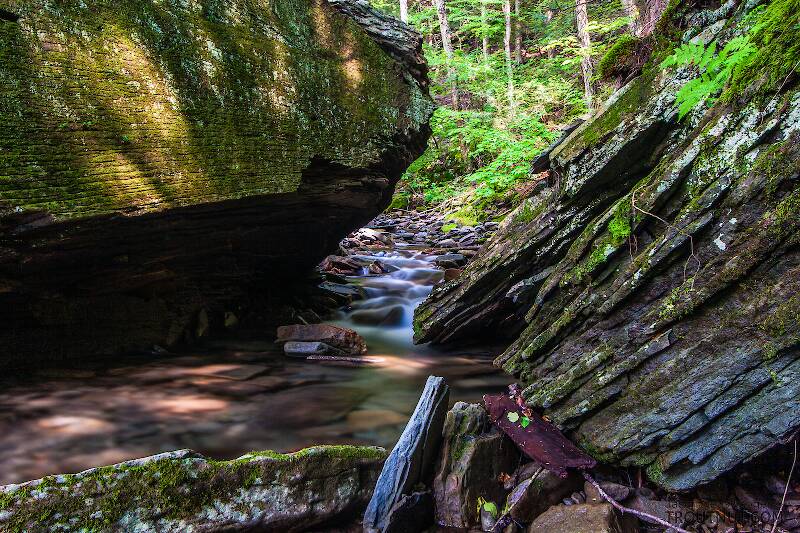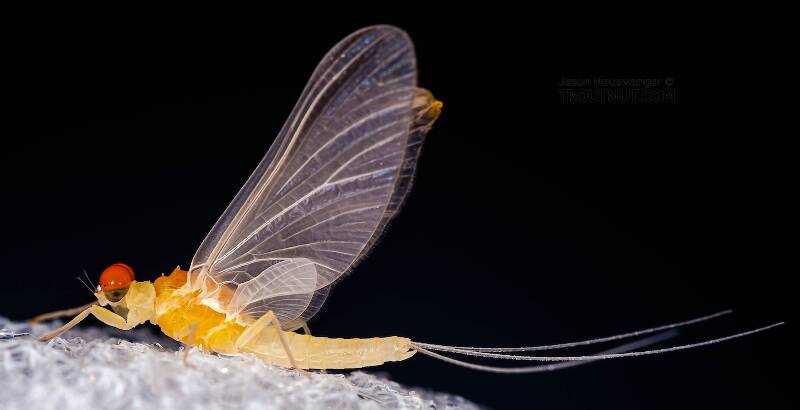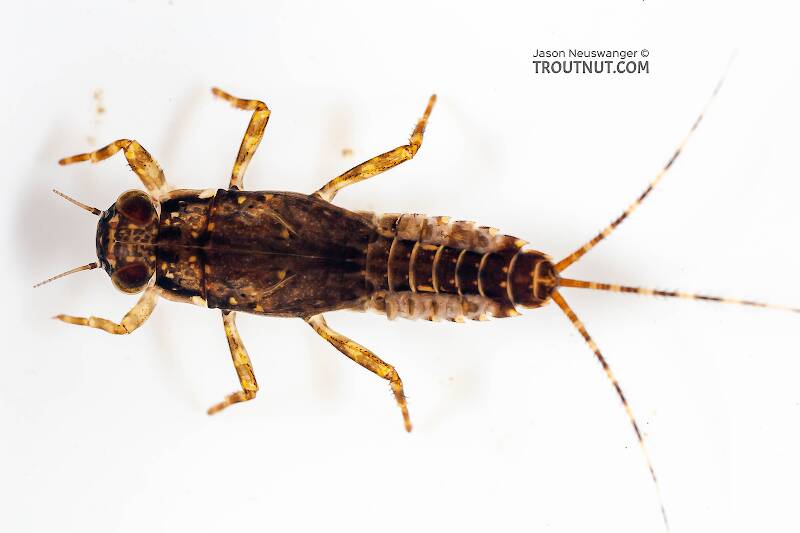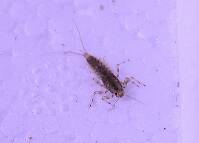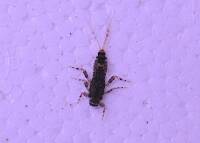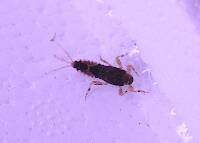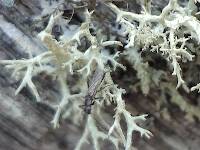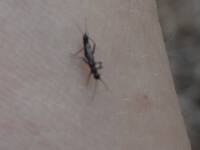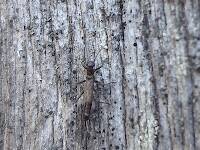
Hex Mayflies
Hexagenia limbata
The famous nocturnal Hex hatch of the Midwest (and a few other lucky locations) stirs to the surface mythically large brown trout that only touch streamers for the rest of the year.
Featured on the forum

Troutnut is a project started in 2003 by salmonid ecologist Jason "Troutnut" Neuswanger to help anglers and
fly tyers unabashedly embrace the entomological side of the sport. Learn more about Troutnut or
support the project for an enhanced experience here.
This topic is about the Mayfly Species Ephemerella dorothea dorothea
Ephemerella dorothea consists of two subspecies, which both produce excellent action. Ephemerella dorothea dorothea is a small species of Sulphur in the East, and Ephemerella dorothea infrequens (formerly Ephemerella infrequens) is one of the two main Pale Morning Dun hatches of the West. The remainder of this page focuses on the dorothea dorothea subspecies, and Ephemerella dorothea infrequens is discussed separately on its own page.This is one of the most challenging mayfly hatches on Eastern waters. On many streams, it follows or overlaps hatches of the larger, lingering Ephemerella invaria.
Example specimens
Troutnut on Jun 13, 2006June 13th, 2006, 8:15 pm EDT
I watched quite a few of these guys emerge tonight. (I think -- they seemed too small and light to be Ephemerella invaria, though I didn't bring one home to check under the microscope.) It was a cool evening but not cold, and they were emerging on the slow flats of a large midwestern spring creek. I watched several of them drift 50+ feet on the very slow-moving water, slowly rising up out of the surface film. Their emergence was sporadic and lucky for them the trout were also sporadic. Many were eaten but others went ignored for their entire lengthy drifts.
Later in the evening I was bested by a half-dozen rising trout. The sulphurs were still emerging, and a mix of spinners was starting to appear on the water, but I didn't get so much as a splashy refusal from several rising fish, even in the low light of dusk. My best guess is that they were picky feeders keying on a stage of Ephemerella dorothea mayflies.
Later in the evening I was bested by a half-dozen rising trout. The sulphurs were still emerging, and a mix of spinners was starting to appear on the water, but I didn't get so much as a splashy refusal from several rising fish, even in the low light of dusk. My best guess is that they were picky feeders keying on a stage of Ephemerella dorothea mayflies.
Jason Neuswanger, Ph.D.
Troutnut and salmonid ecologist
Troutnut and salmonid ecologist
Wiflyfisher on Jul 24, 2007July 24th, 2007, 2:24 pm EDT
Jason, I was watching helpless PMD nymphs drifting downstream last week for well over 100 yards. I waded behind some nymphs and I was amazed how long they were drifting just below the surface film in the slow moving current. Along the bank there was some colder, spring-fed water that may have been influencing the long drifts. The large rainbows were slowly sliding in and out along the bank looking for the vulnerable PMD nymphs and emergers. It was as much fun to watch as it was to fish. It makes me wonder how long do some nymph species drift before emerging.
John S.
https://WiFlyFisher.com
https://WiFlyFisher.com
Konchu on Jul 25, 2007July 25th, 2007, 5:45 am EDT
Jason, this time of year, your midwest Ephemerella probably was excrucians, which had been misidentified as dorothea for a long time. Dorothea is restricted mostly to mountainous (or formerly mountainous) regions of North America. In general appearance, dorothea and excrucians can be tough to differentiate.
In the lab, I've seen nymphs drift for over an hour before they emerged. On top of that, some of the duns took over 45 minutes to get out of the shuck and off the water. I suspect that a lot of these slow ones get knocked off by fish.
In the lab, I've seen nymphs drift for over an hour before they emerged. On top of that, some of the duns took over 45 minutes to get out of the shuck and off the water. I suspect that a lot of these slow ones get knocked off by fish.
GONZO on Jul 25, 2007July 25th, 2007, 10:28 am EDT
Interesting stuff about dorothea, Konchu. Gene Macri, who did his thesis research on Falling Spring (a small limestone spring creek in the Cumberland Valley, PA) says that the smaller, later "sulphurs" that are often thought to be dorothea on that stream are actually an extension of the invaria activity. According to Gene there are no dorothea in Falling Spring, though the later invaria mimic them in size and timing. (He actually insists upon calling them rotunda, but he's stubborn about that.) I often wonder if that same thing pertains to other streams where the smaller, later sulphurs are just assumed to be dorothea.
Wiflyfisher on Jul 25, 2007July 25th, 2007, 10:50 am EDT
So are we saying the late May little mayfly hatch (size #18) that occurs in NW Wisconsin is not E. dorothea, but instead is E. excrucians, or a smaller E. invaria?
Dorothea is restricted mostly to mountainous
What I was seeing in the mountains of Idaho last week (Pale Morning Duns - size #18) could have been E. dorothea?
Aquatic entomology used to be soooo simple. It's like somebody just re-shuffled the deck! :-)
John S.
https://WiFlyFisher.com
https://WiFlyFisher.com
GONZO on Jul 25, 2007July 25th, 2007, 11:01 am EDT
John, my sympathies about the deck reshuffling; it does get confusing. I'll let Konchu deal with the hard questions, but one of the Western PMDs was the old E. infrequens. That former species is now thought to be a subspecies of dorothea, hence E. dorothea infrequens. Funny, I remember some guys on a Western site discussing how "sulphurs" had been "discovered" in the West. Of course, they were there all along, just under a slightly different name.
Wiflyfisher on Jul 25, 2007July 25th, 2007, 11:07 am EDT
Now we have subspecies of species? Not only has the deck been re-shuffled but it appears the rules have changed too. :)
*** dorothea infrequens *** Why not call it "doroquens"?????
*** dorothea infrequens *** Why not call it "doroquens"?????
John S.
https://WiFlyFisher.com
https://WiFlyFisher.com
GONZO on Jul 25, 2007July 25th, 2007, 11:20 am EDT
:) Actually, John, I would have thought that Eastern fly fishers would be thrilled now that they can just use their sulphur imitations out West! (Of course, with all the color variations, I guess it doesn't really work that way. Oh well . . . .)
Wiflyfisher on Jul 25, 2007July 25th, 2007, 11:22 am EDT
I landed a beautiful 20" bow on one of my Midwest E. dorothea emerger patterns. :)
John S.
https://WiFlyFisher.com
https://WiFlyFisher.com
GONZO on Jul 25, 2007July 25th, 2007, 11:25 am EDT
There you go! See, your fly-fishing life just got simpler. :)
(Although, are you sure it wasn't really a Midwest E. excrucians emerger?) ;)
(Although, are you sure it wasn't really a Midwest E. excrucians emerger?) ;)
Wiflyfisher on Jul 25, 2007July 25th, 2007, 11:34 am EDT
It was actually a "PYOME-18". That stands for: Pale Yellow/Olive Mayfly Emerger - size 18. See all we need to do is start using SKU numbers for identifying specific species. If we get real good we can barcode them too. ;)
Geesh, I use to enjoy matching the hatch. It's a good thing the trout aren't so educated. :-)
Geesh, I use to enjoy matching the hatch. It's a good thing the trout aren't so educated. :-)
John S.
https://WiFlyFisher.com
https://WiFlyFisher.com
Konchu on Jul 25, 2007July 25th, 2007, 11:41 am EDT
"I landed a beautiful 20" bow on one of my Midwest E. dorothea emerger patterns. :)"
$#!%. I guess I'll have to shuffle the names again, if the midwestern fish insist on hitting the dorothea emerger. You know the fish can't be wrong.
$#!%. I guess I'll have to shuffle the names again, if the midwestern fish insist on hitting the dorothea emerger. You know the fish can't be wrong.
GONZO on Jul 25, 2007July 25th, 2007, 11:41 am EDT
Bar codes!!! Now that's a really good idea! (Quick, I have to patent a streamside mayfly bar code scanner!) :)
Wiflyfisher on Jul 25, 2007July 25th, 2007, 11:55 am EDT
Okay you guys let's get back to the basics here! :-) Life was good in the late 1970's and 1980's, we learned our aquatic insects latin names and the trout sometimes agreed. Now we are adding another layer to the database for aquatic insects -- subspecies. We gotta stop that! :)
If you insist on adding new category grouping then here is my idea to take the confusion out of matching the hatch. We go to our local flyshop and pick up a box of Gonzo's flies all labeled by SKU numbers that match each insect.
I would bet each insect has a unique eyeball configuration. So we create the ultimate, miniature eyeball scanner! Just grab a fly from the water and run it by the scanner and presto we know the SKU number. A small PC device inside your vest is connected to the scanner via a small pin-on retractor. After scanning the mayfly the appropriate Gonzo fly box pops open and voila... the imitation to use is right in front of you!
If you insist on adding new category grouping then here is my idea to take the confusion out of matching the hatch. We go to our local flyshop and pick up a box of Gonzo's flies all labeled by SKU numbers that match each insect.
I would bet each insect has a unique eyeball configuration. So we create the ultimate, miniature eyeball scanner! Just grab a fly from the water and run it by the scanner and presto we know the SKU number. A small PC device inside your vest is connected to the scanner via a small pin-on retractor. After scanning the mayfly the appropriate Gonzo fly box pops open and voila... the imitation to use is right in front of you!
John S.
https://WiFlyFisher.com
https://WiFlyFisher.com
Wiflyfisher on Jul 25, 2007July 25th, 2007, 11:59 am EDT
$#!%. I guess I'll have to shuffle the names again, if the midwestern fish insist on hitting the dorothea emerger. You know the fish can't be wrong.
Konchu, it was a Rocky Mountain, Western **trout** that ate my Midwest E. dorothea emerger pattern. Is that better or worse?
John S.
https://WiFlyFisher.com
https://WiFlyFisher.com
GONZO on Jul 25, 2007July 25th, 2007, 12:22 pm EDT
We go to the local flyshop and pick up a box of Gonzo's flies . . . .
Good plan, John, but here's the catch: We all know that Gonzo's flies are just too damned difficult and nobody really ties them. (Except maybe Louis, and he's hopeless.) Commercial tiers just shake their heads and say, "What the #*%$!" Gonzo's flies are just a clever ruse designed to frustrate poor unsuspecting fly fishers and make them feel inadequate--just like scientific names for mayflies! :)
Wiflyfisher on Jul 25, 2007July 25th, 2007, 12:51 pm EDT
Lloyd, we all know commercial tiers dance to a different drummer. What I really liked about your flies and your book was it was not another "me-to" book. (That is why I buy few FF books anymore.) Flies, rods, lines, leaders and tactics have all changed dramatically over the years and not everyone has always accepted the changes.
BTW, I found some terrific grouse hackle, CDC and turkey biots out West at Trout Hunter (www.TroutHunt.com). At Mike Lawson's Henry's Fork Anglers I picked some wonderful Whiting's "Pro Grade" necks for $22 each.
BTW, I found some terrific grouse hackle, CDC and turkey biots out West at Trout Hunter (www.TroutHunt.com). At Mike Lawson's Henry's Fork Anglers I picked some wonderful Whiting's "Pro Grade" necks for $22 each.
John S.
https://WiFlyFisher.com
https://WiFlyFisher.com
Gene
Posts: 107
Posts: 107
Gene on Aug 11, 2007August 11th, 2007, 7:07 pm EDT
Since my name was mentioned in this post. I thought I would reply especially to whoever is from Boiling Springs. Yes, I did my M.S. on Falling Spring in Chambersburg PA which was one of the legendary spring creeks of fly fishing history. I used to fish the stream for years and years sometimes with the legendary Charlie Fox. Fox loved the sulfurs. It was his favorite hatch (on the Letort too) In fact, I've done more research on the limestone spring creeks of Pennsylvania than anyone. All of the sulfur mayflies in Falling Spring that I know of especially when I did my research are Ephemerella rotunda Morgan which has been changed by McCafferty to Ephemerella invaria since E. invaria was the first described species of the group and would take taxonomic preference. However, in reference to the someone who said that I still insist on referring to them as E. rotunda I would like to explain to this gentleman that taxonomy is an arbitrary science at best. Unless Dr. McCafferty has DNA evidence (I hope he does) than that doesn't mean that he is correct. Although, if the DNA evidence is there that would make it invaria but there are number of us who do this stuff for a living who believe there are taxonomic differences between the two which may be worthless if DNA evidence proves otherwise.
Second, those who quote my thesis should read the introduction. I had all my sulfurs verified by Flowers at Florida A & M Univ. who is considered one of the finest aquatic entomologists in the country. Furthermore, I had not only stream specimens but I raised nymphs to mature adults in the lab from the stream because I wanted virgin imago males (please I hear you laughing but once the little buggers mate they screw up their genitalia; please no comments about humans on this). I once had a girl friend lose it when she saw what I was doing! Also, Flowers had every range of specimens in terms of size and months from April to November. As the size decreased from 12 in the spring to near 18 in fall mayflies did not resemble anything but E.rotunda. This species shows great variation in coloration and size (I have made a study of the sulfurs over the years) and number of spines on male genitalia. I looked at literally thousands and thousands of those male spinners during this time period. Yes, Falling Spring has very few hatches like it did then. Its sulfur hatches were unreal!
Ephemerella dorothea is a a mayfly that I believe inhabits warmer waters and many marginal trout streams (Greg Hoover at Penn State believes this also). There is always a chance that a new species of sulfur could have colonized F. Spring or any other stream that previously contained only E. invaria but I have reared these flies from many different streams and have done samplings across the East coast and almost everything I find is usually E. invaria (rotunda). It is one of the most widely distributed mayflies in trout streams and is an important water quality indicator.
One other point on classification many years ago while I was doing research on the Tricos the country's leading expert told me that there couldn't be any of the species I found because that species wasn't East of the Mississippi. Needless to say he was wrong so take classification, taxonomy and even distribution maps for what they are: arbitrary! They can be an aid but like everything else they must always be kept in the proper context. If you have specimens (male spinners) of the Ephemerellas and you would like them identified just send them to me and I'll be glad to take a look at them free of charge. You can find my address at: wwww.eugenemacri.com; www.flyfisher.com or www.limestoner.com.
Tight lines
and rising trout for everyone; and drink a beer and pray this heat wave leaves and we get some rain in PA.
gene macri
Second, those who quote my thesis should read the introduction. I had all my sulfurs verified by Flowers at Florida A & M Univ. who is considered one of the finest aquatic entomologists in the country. Furthermore, I had not only stream specimens but I raised nymphs to mature adults in the lab from the stream because I wanted virgin imago males (please I hear you laughing but once the little buggers mate they screw up their genitalia; please no comments about humans on this). I once had a girl friend lose it when she saw what I was doing! Also, Flowers had every range of specimens in terms of size and months from April to November. As the size decreased from 12 in the spring to near 18 in fall mayflies did not resemble anything but E.rotunda. This species shows great variation in coloration and size (I have made a study of the sulfurs over the years) and number of spines on male genitalia. I looked at literally thousands and thousands of those male spinners during this time period. Yes, Falling Spring has very few hatches like it did then. Its sulfur hatches were unreal!
Ephemerella dorothea is a a mayfly that I believe inhabits warmer waters and many marginal trout streams (Greg Hoover at Penn State believes this also). There is always a chance that a new species of sulfur could have colonized F. Spring or any other stream that previously contained only E. invaria but I have reared these flies from many different streams and have done samplings across the East coast and almost everything I find is usually E. invaria (rotunda). It is one of the most widely distributed mayflies in trout streams and is an important water quality indicator.
One other point on classification many years ago while I was doing research on the Tricos the country's leading expert told me that there couldn't be any of the species I found because that species wasn't East of the Mississippi. Needless to say he was wrong so take classification, taxonomy and even distribution maps for what they are: arbitrary! They can be an aid but like everything else they must always be kept in the proper context. If you have specimens (male spinners) of the Ephemerellas and you would like them identified just send them to me and I'll be glad to take a look at them free of charge. You can find my address at: wwww.eugenemacri.com; www.flyfisher.com or www.limestoner.com.
Tight lines
and rising trout for everyone; and drink a beer and pray this heat wave leaves and we get some rain in PA.
gene macri
Taxon on Aug 11, 2007August 11th, 2007, 11:10 pm EDT
Gene-
Welcome to the forum. I am sorry you found it necessary to defend your position in your first post here. I went back and studied the post which refers to your research, and I can assure you that no slight was intended. Actually, quite the opposite. In any event, I hope you will put that aside, and continue to share your extensive mayfly knowledge and experience with all of us.
Sincerely,
Welcome to the forum. I am sorry you found it necessary to defend your position in your first post here. I went back and studied the post which refers to your research, and I can assure you that no slight was intended. Actually, quite the opposite. In any event, I hope you will put that aside, and continue to share your extensive mayfly knowledge and experience with all of us.
Sincerely,
Martinlf on Aug 12, 2007August 12th, 2007, 4:09 am EDT
Gene, I too would like to welcome you to the forum. I know the gentleman from Boiling Springs a bit, and that he holds your research in the very highest esteem, seeing you as someone who has provided important and accurate information about a much misunderstood phenomena. He is not active on this forum now, busy with work-related issues. I do believe that he'd be thrilled that you have posted here, and as Taxon said, that he meant no slight in his original post. He was clearly impressed when he related your findings to me months ago, and I recently explained your research to a friend who lives in Chambersburg and who fishes Falling Spring frequently. He had mentioned dortheas there and I told him that I believed you had proven that they weren't. It is very interesting to see your views on these two sulphur species and to note that water temperature may be a factor. Do you know of any differences between the two bugs that may be significant to the fly fisher, such as manner or quickness of emergence?
"He spread them a yard and a half. 'And every one that got away is this big.'"
--Fred Chappell
--Fred Chappell
Quick Reply
Related Discussions
Topic
Replies
Last Reply
0
Jun 29, 2020
by Wiflyfisher
by Wiflyfisher
1
Sep 14, 2010
by SlateDrake9
by SlateDrake9
4
Sep 4, 2015
by PaulRoberts
by PaulRoberts
1
Aug 21, 2007
by Gene
by Gene

